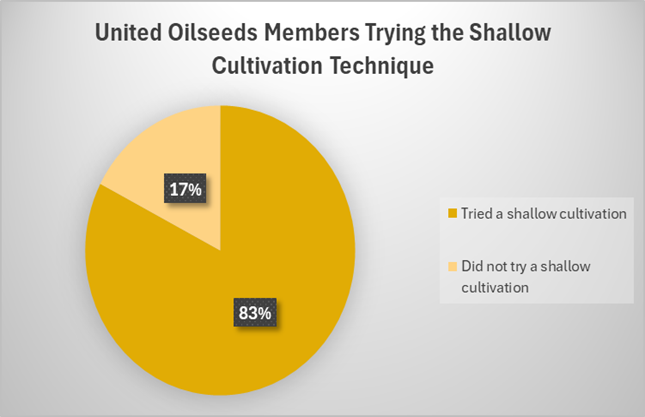
Most reports this year indicate that CSFB has been significantly less problematic for the farming community compared to last year. Establishment figures are encouraging, with losses averaging just 4% this season, a marked improvement from the 10% recorded at the same time last year. However, many of the losses seen this year are attributed to slugs and adverse weather conditions, which have posed challenges for some growers. From what we’ve seen and heard, crops in the field are generally looking well-established despite these pressures.
While CSFB hasn’t been completely eradicated, the impact of these tiny, hopping adversaries has thankfully diminished considerably. Given their reputation as one of the most challenging pests in recent years, we decided to look further into the potential reasons behind this welcome decline.
Cultivation after harvest
If you recall, back in July we called for all OSR growers in the UK to undertake a post harvest shallow cultivation, https://www.unitedoilseeds.co.uk/post-harvest-cultivation, based on research from Colin Peters at NIAB, which showed a reduction in CSFB numbers emerging from the soil of up to 90% by using this technique.
So we decided to ask our members if they gave this a try following harvest in 2024.

And we were pleased to see the results which confirmed our members saw the benefit of this low impact, low cost and simple mitigation strategy.
While we still need to delve further into CSFB pressure across respondents’ farms, it does appear that this simple technique may have helped limit emergence this year.
Contributing factors
Weather & climate will always play a crucial role in pest populations. We’ve had multiple conversations with growers in regions severely affected by floods in the winter of 23/24 where it has been suggested that all of the CSFB drowned. It’s pretty hard to disagree with that argument, but unfortunately we won’t be advocating for more floods to reduce the flea beetle population any time soon!
Natural pest population cycles
Pest populations often follow natural cycles, with peaks and troughs occurring over several years. Flea beetles are no exception. After several years of high infestations, we may be entering a natural decline phase. It may even be the case that we’ve seen a post neonic boom followed by a naturally occurring levelling off.
Grazing OSR
Through discussions with our members, it seems that grazing of early-planted OSR has been more widespread over recent years. This practice not only helps manage excessive autumn growth but also serves as an effective alternative to growth regulators in the run-up to Christmas.
Grazing can regulate canopy size by removing excess biomass, ensuring the crop enters winter with a balanced structure that supports strong spring recovery. Additionally, grazing offers the added bonus of potentially reducing CSFB pressure, as livestock may consume the pests while grazing. It also improves crop health by removing diseased or damaged leaves, promoting fresh, resilient growth, and enhances soil fertility by recycling nutrients through manure. By integrating livestock into arable systems, grazing OSR provides a sustainable, cost-effective strategy to optimise productivity and resource efficiency across the farm.
Spatial separation
A practice that has shown success in Sweden and other parts of Europe involves maintaining a minimum spatial separation between oilseed rape (OSR) crops in consecutive years to manage pest populations. This approach disrupts the life cycle of pests, Studies indicate that increasing the distance between fields of OSR can significantly reduce pest infestations by limiting their ability to move between host plants. Additionally, it helps in reducing pathogen carryover, such as soil-borne diseases that thrive with frequent OSR cropping in the same fields.
Additional strategies
Other potential reasons for this year’s reduction in CSFB pressure could be the adoption of alternative strategies such as using slurry to mask the scent of crops as a way to confuse CSFB and reduce their ability to locate their host plants. Companion cropping, using buckwheat or clover, has also gained traction. This technique not only supports pest deterrence but also improves soil health and promotes biodiversity.
Conclusion
Unfortunately there is still no silver bullet to combat CSFB, more likely it’s a combination of factors, from the post harvest cultivation, improved crop management practices, and the weather/climate which have helped reduce numbers this year.
While the decrease is a relief for many farmers, it’s essential to remain vigilant. Pest populations can rebound quickly, especially with changes in weather patterns. That said, hopefully there will be a knock on effect of lower populations of CSFB this year, with less larval emergence in spring 2025.
Tools like the MagicTrap are paving the way for smarter, more sustainable pest management strategies, allowing farmers to protect their crops while reducing chemical inputs.
Let's hope this year’s decline is not just a lucky break, but a sign that we are learning to manage these pests more effectively.
